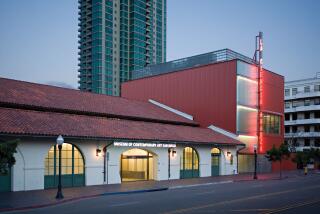A Precious Exhibition : Pre-Columbian Gold Works Are Focus of Show at Bowers Museum
- Share via
SANTA ANA — The shimmering regalia, all made of gold, must have been blinding: Nose rings, lip rings, earrings, necklace, face mask, breastplate, arm, wrist, leg and ankle braces. High shaman, priest or chieftain, in pre-Columbian Indian societies, the higher your standing, the more gold you wore.
“Practically no part of the body was left uncovered with gold,” says Armand J. Labbe, co-curator of a major exhibition of pre-Columbian gold works that shapes up to be one of the most popular displays on view at the new and improved Bowers Museum of Cultural Art.
“Tribute to the Gods: Treasures of the Museo del Oro” features 300 gold works plus 30 ceramic pieces from throughout Colombia and date from 300 BC to AD 1600.
Pre-Columbian indigenous peoples believed that all living things were inextricably linked--to each other and to the world around them; that man and animal, planet and plant, sea and sky were governed by the same sacred laws of nature. In this integrated realm, gold was believed to be a conduit for procreative power of the sun, seen as the supreme source of all life-giving energy.
“It has its meaning deep in the sacred mythology of the people, who associated its yellow color with the sun, from which they believed it received creative energy,” said Ana Maria Falchetti, assistant director of the Museo del Oro, who organized the exhibit with that museum’s director, Clemencia Plazas, and Labbe, the Bowers’ director of research and collections.
Gold objects were “put in the temple where sunlight hit them, and allowed to absorb the sun’s energy, and that energy fertilized the person wearing or using them,” says Labbe, a noted pre-Columbian art scholar.
The Museo del Oro (Museum of Gold), in Bogota, Colombia, houses some 33,000 objects. To foster better understanding of Colombia’s indigenous societies and preserve its cultural patrimony, the country’s central bank, the Banco de la Republica established the museum in 1939. The bank has controlled the country’s gold trade for most of the century, according to museum officials.
Before Peter C. Keller became Bowers’ executive director early last year, he curated two exhibits of work from the Museo del Oro. Those exhibits were shown at the Natural History Museum of Los Angeles County, where Keller was associate director for public programs.
The luminous Colombian objects include an evocative face mask hammered out of crinkly, foil-thin gold, solid gold wrap-around wrist guards, bold breastplates, nose rings as thick as a finger, earrings with dangling, cone-shaped pendants as big as coconuts, emblems of office, such as staff finials, and detailed votive figures used in funeral offerings and other rituals.
Some items are highly abstract, depicting stylized shamans, priests or chieftains; others tend toward realism, with animal, deity, human or anthropomorphic iconography. Ceramic urns and figures such as those on view were often entombed, like many of the gold items, with their deceased owners.
Discussing the exhibit at Bowers recently, Labbe and Falchetti said highly skilled and respected pre-Columbian metal smiths from several cultural regions of Colombia developed a great variety of techniques and styles.
“The works represent a high point in technical and artistic achievement in the Americas,” Labbe said.
“In Colombia, most cultures didn’t have monumental architecture”--like the pyramids of Mexico--”so the thing that distinguishes the country is metallurgy,” said Falchetti, who wrote her master’s thesis on Colombian metallurgy at the University of London’s Institute of Archeology. She has worked at the Museo del Oro for the past 20 years.
The gold works’ imagery and iconography reflect indigenous Colombians’ mythology and belief in man’s close relationship with nature, Falchetti said. Several pieces, for instance, combine human facial features with the teeth of jaguars, thought to represent strength.
“They believed men could transform themselves into animals to obtain the animal’s powers,” she said, “and would dance and take (natural hallucinogenic substances) to go into the natural world to do this.”
The works in “Tribute to the Gods” represent many distinct cultural groups’ preferences in technique and style, Falchetti said. Some preferred abstraction over realism, pure gold over alloys, or casting over hammering and embossing methods, for instance.
“Each culture had its own evolution and geography and approach to the natural world (reflected) in the different expressions,” she said.
Museo del Oro director Plazas writes in the exhibit’s catalogue that “the Spanish conquest and the ensuing pursuit of gold and riches . . . all but totally destroyed the indigenous cultures of Colombia.” Labbe said the show was nonetheless chosen as the Bowers’ contribution to the Christopher Columbus Quincentenary celebration because “gold epitomized the highest achievement of artistry in the New World.”
“You might come for the sheer beauty of 300 pieces of gold made by people that, in the main, have disappeared,” he said. “Or, you might come to try to understand something about yourself and how this culture reflects your mind. We are all walking encyclopedias of the past that have been covered over by the veneer of modern cultural conditioning. When we’re alone at night without (the glare of) city lights, we seem to believe in the same things” as our predecessors.
* “Tribute to the Gods: Treasures of the Museo del Oro,” runs through March 1 at Bowers Museum of Cultural Art, 2002 N. Main St., Santa Ana. Hours are Tuesday through Sunday, 10 a.m. to 5 p.m. $1.50-$4.50. (714) 567-3600.
More to Read
The biggest entertainment stories
Get our big stories about Hollywood, film, television, music, arts, culture and more right in your inbox as soon as they publish.
You may occasionally receive promotional content from the Los Angeles Times.










